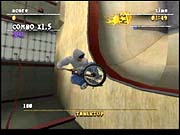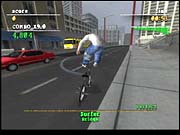Mat Hoffman's Pro BMX was Activision's first Tony Hawk spin-off. It succeeded on the PlayStation by sticking close to the formula laid out by the first two Tony Hawk games and by being one of the only products on the market at the time that could satisfy Hawk fiends in search of a similar experience. Needless to say, the action sports market is infinitely more crowded in 2002. Activision is spinning off in as many different directions as it can, Acclaim has carved its own niche out, and a lot of the second- and third-tier third parties are pumping out clones as quickly as possible. You can't put out a game that simply clones the Tony Hawk gameplay and expect to draw a crowd anymore. With that in mind, Mat Hoffman's Pro BMX 2 adds a few levels of complexity to the series' gameplay, giving you more control over your rider. Unfortunately, the game's shallow goal design keeps it from achieving the same level of addictiveness as competing games like Tony Hawk's Pro Skater 3 and Aggressive Inline.

The game's main career-style mode takes the form of a road trip. The idea is that you're rolling around the US in a tour bus and stopping in select cities such as Las Vegas, Chicago, and New Orleans. Each level has its own theme and layout and comes complete with 12 goals. Like in the Dave Mirra series, the goals are broken up into multiple layers. You're given four goals at a time, and you must complete those four before moving on to the next set. Each set has one score-based goal. Most sets also seem to have some form of collection goal in them, which really brings the game down. The trick-based goals, such as performing a special trick while transferring over a large sign or landing a specific trick in a specific location, are rarely a problem. So you're left to wander around each level, looking for slot machine tokens, roller coaster tickets, tree stumps to trick over, bridge toll tokens, or some other set of objects. The weight placed on the collection goals and the generally limited goal structure keep the road trip from ever becoming too exciting. You'll collect items as you play through the road trip mode, including new bikes with different stats, new costumes, and, in an interesting twist, new songs that slide into the soundtrack rotation when picked up. Beyond the road trip mode, the game features the standard batch of modes you'd expect to find in an action sports game, such as free runs and a two-player split-screen mode with a handful of new games that inject some much-needed replay value into the game.
The levels are colorful and well textured, but they feel a little empty when compared with some of the line-filled levels in Tony Hawk 3 and Aggressive Inline. The abundance of open space in the levels is probably designed to force you to get good at the game's most interesting new gameplay mechanic, the addition of flatland tricks. Flatland tricks are performed from manual positions and work identically to the handstand, truckstand, and other flatland tricks found in Tony Hawk 3. The major difference here is that the tricks are significantly more impressive looking and there are a lot more of them. But since maintaining your manual balance during these tricks is super easy, there's little challenge associated with the tricks, so they're mostly there for show and for making huge combo scores much easier to attain. The other significant control change is the addition of a modifier button, which was jacked directly from the Dave Mirra games. Here, you'll perform a trick, and then immediately following the trick execution, you'll hit the modifier button and a direction to modify the trick. This lets you perform variations on existing tricks, like one-hand, one-foot, no-hand, no-foot, and half-and-half versions of tricks. The game is pretty good about preventing you from performing "impossible" tricks, like the mind-bendingly hilarious no-handed superman found in the Dave Mirra games, but there are still one or two instances--Mat's no-handed barhop, for example--in which you can perform physically impossible tricks and rotate the bike back and forth without having the rider lay a finger on it.
Beyond the nice-looking level textures, the rest of Pro BMX 2 looks pretty good, though the game has a slightly blurry look to it in general. The various costumes are cool and occasionally pretty funny. The riders move very well, and their animation is full of realistic nuances, such as wobbling a bit when you just barely land a trick. The game also has its share of FMV, most of which was shot by Activision during a real-life road trip on which the game's riders drove around, getting into trouble. Each rider has his own collection of clips. Mat Hoffman's seem to focus on how he's constantly wrecking his bike and getting injured. The game mirrors this pretty well, as the crash animations are suitably painful looking. It's too bad the GameCube version of the game displays most of its FMV in a small, blurry window that doesn't seem to quite match the proportions of a standard television, and as a result the videos all look a little too wide.

The first Mat Hoffman had an eclectic soundtrack that managed to collect a lot of great songs while covering a lot of ground from a genre standpoint. The second soundtrack attempts to duplicate that success by culling its tracks from a variety of genres and eras. A total of 20 tracks from bands and artists such as Dub Pistols, Bombfunk MCs, Ice T, LL Cool J, and Suicidal Tendencies are included. While it carries on the genre mixing of the first game, the soundtrack simply don't mesh together as well as the first game's did. You can edit the playlist to turn off tracks that don't suit your fancy.
The first Mat Hoffman game essentially cloned the Tony Hawk games. This new entry, however, seems like it was designed to cater to the Dave Mirra crowd. The main focus is the flatland tricks, which look nice but really don't bring a lot to the table from a gameplay perspective. In the end, this game can be recommended only to die-hard action sports fans who won't mind the game's almost clinical approach to its level, goal, and gameplay design. Anyone looking for a game with a little more soul would be better served by Aggressive Inline or Tony Hawk's Pro Skater 3.